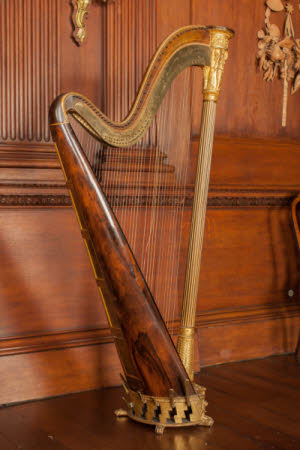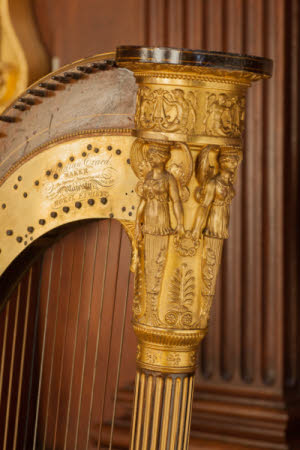Harp
Sebastien Erard (1752 - 1831)
Category
Musical instruments, devices and recordings
Date
1829
Materials
Measurements
170 x 42 cm
Place of origin
London
Order this imageCollection
Lyme, Cheshire
NT 500496
Caption
Eliza Hancock, later the Comtesse de Feuillide, Jane Austen's spirited first cousin, was living in Paris in 1780 when she described the harp as ‘at present the fashionable instrument.’ The taste for these large but delicate instruments had certainly reached English circles some fifty years later, when in 1829, Thomas Legh, master of Lyme Park, purchased this beautiful Grecian harp. In England, the harp had a long and distinguished pedigree and was particularly associated with the great Welsh harpers of the earlier 18th century. But soon after the invention of the single-action pedal harp, France became the main centre for cultivation of the instrument and its music. The maker of this particular harp was the Frenchman, Sébastien Erard. Prior to establishing his firm in London, Erard was closely associated with the Bourbon court including the harp-playing Marie Antoinette, whose arrival to Versailles in 1770 fuelled the rage for the instrument amongst the French elite. But by the early 1790s, with many of his clients facing certain death by guillotine, Erard fled France for London where he established a shop on Great Marlborough Street. There he honed his craft to such a degree that by 1794 he took out the first British patent for the harp to protect his innovations. In 1800, the Princess of Wales bought one of his harps and the success of his firm was ensured; by 1810 he had sold nearly 1400 of his stringed instruments from his London outlet alone. Eliza de Feuillide, whose royalist husband was guillotined in 1794, had long since returned to England where harp playing continued to be the pastime of the wealthy and the privileged. After her second marriage to Henry Austen (Jane’s older brother), Eliza held parties at her London home where professional harpists performed. Interestingly, in 1814, Fanny Knight, Jane and Eliza’s niece, began studying the harp and herself became a client of the Erard firm, continuing the Franco-British dialogue around the harp and its repertoire.
Summary
Grecian harp made by Sebastian Erard, 18 Great Marlborough Street, London, with rosewood-veneered body and unpainted sound board with gilt lined detailing and gilt fluted column. Model number 4250 inscribed on back of sound board, March 1829 stamp to base of pedal box - R 4351. According to the Erard ledgers it appears harp no. 4250, completed in July 1829 and sold to Thomas Legh Esq of Lyme Park on 24 September 1829.
Full description
Grecian harp made by Sebastian Erard, 18 Great Marlborough Street, London. Model number 4250, handwritten on back of sound board. March 1829 Stamp to base of pedal box - R 4351. Rosewood veneered body and unpainted sound board with gilt lined detailing and gilt fluted column. According to the Erard ledgers it appears Erard harp 4250 was completed in July 1829 and sold to Thomas Leigh Esq of Lyme Park on Sept 24 1829.
Provenance
Original to the house.
Makers and roles
Sebastien Erard (1752 - 1831), maker


